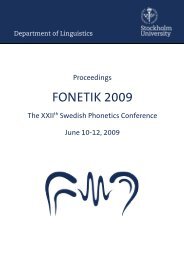The Double Passive in Swedish - Institutionen för lingvistik ...
The Double Passive in Swedish - Institutionen för lingvistik ...
The Double Passive in Swedish - Institutionen för lingvistik ...
Create successful ePaper yourself
Turn your PDF publications into a flip-book with our unique Google optimized e-Paper software.
Contents<br />
Abbrevations ......................................................................................... 8<br />
1. Introduction .................................................................................... 9<br />
2. Background ................................................................................... 10<br />
2.1 <strong>Swedish</strong> <strong>in</strong> brief ................................................................ 10<br />
2.2 <strong>Passive</strong> voice ..................................................................... 11<br />
2.3 Lexical functional grammar .................................................. 12<br />
2.4 Constituents of the <strong>Double</strong> <strong>Passive</strong> ...................................... 14<br />
2.4.1 Inf<strong>in</strong>itival complements and PRO ....................... 14<br />
2.4.2 Matrix verbs .................................................. 15<br />
2.4.2.1 Equi verbs ................................. 15<br />
2.4.2.2 Rais<strong>in</strong>g verbs ............................. 15<br />
2.4.3 Demoted agents ............................................ 16<br />
2.4.3.1 Non-overt agents ......................... 16<br />
2.4.3.2 Animacity ................................... 16<br />
2.5 <strong>Double</strong> <strong>Passive</strong> constructions .............................................. 17<br />
2.6 Restrictions on the <strong>Double</strong> <strong>Passive</strong> ...................................... 18<br />
2.6.1 Expletive SUBJ and extra PREP ........................ 18<br />
2.6.2 Lack of control ............................................... 19<br />
2.7 Restrictions on the verbs .................................................... 19<br />
2.7.1 Only passive <strong>in</strong>f<strong>in</strong>itives ................................... 19<br />
2.7.2 Deponents .................................................... 19<br />
2.7.3 Parasitic mark<strong>in</strong>g ........................................... 20<br />
2.8 Subject and object control .................................................. 21<br />
2.9 Complementizers and <strong>in</strong>tegration ......................................... 22<br />
3. Purpose ........................................................................................ 26<br />
4. Method .......................................................................................... 27<br />
4.1 Corpus research ................................................................ 27<br />
4.1.1 Data ............................................................. 27<br />
4.1.2 Material ........................................................ 27<br />
4.1.2.1 Corpora .............................................. 27<br />
4.1.2.2 Tool for analysis .................................. 28<br />
4.1.3 Procedure of the corpus research (<strong>in</strong> brief) ........ 28<br />
4.2 Syntactic and semantic mapp<strong>in</strong>g ......................................... 28<br />
4.2.1 Control and argument structures ...................... 28<br />
6

















